Test: Table Analysis - 1 - GMAT MCQ
15 Questions MCQ Test - Test: Table Analysis - 1
Directions: Study the following table and answer the questions based on it.
Expenditures of a Company (in Pesetas) per Annum Over the given Years.
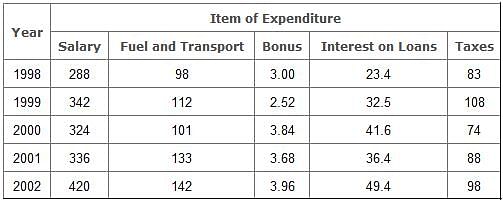
Q. What is the average amount of interest per year which the company had to pay during this period?

Directions: Study the following table and answer the questions based on it.
Expenditures of a Company (in Pesetas) per Annum Over the given Years.

Q. Total expenditure on all these items in 1998 was approximately what percent of the total expenditure in 2002?

| 1 Crore+ students have signed up on EduRev. Have you? Download the App |
Directions: Study the following table and answer the questions based on it.
Expenditures of a Company (in Pesetas) per Annum Over the given Years.

Q. The ratio between the total expenditure on Taxes for all the years and the total expenditure on Fuel and Transport for all the years respectively is approximately?

Directions: Study the following table and answer the questions based on it.
Expenditures of a Company (in Pesetas) per Annum Over the given Years.

Q. The total amount of bonus paid by the company during the given period is approximately what percent of the total amount of salary paid during this period?
Directions: Study the following table and answer the questions based on it.
Expenditures of a Company (in Pesetas) per Annum Over the given Years.

Q. The total expenditure of the company over these items during the year 2000 is?
Directions: The following table gives the percentage of marks obtained by seven students in six different subjects in an examination.
The Numbers is the Brackets give the Maximum Marks in Each Subject.
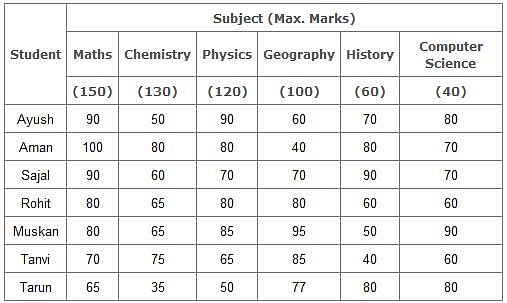
Q. What are the average marks obtained by all the seven students in Physics? (rounded off to two digit after decimal)
Directions: The following table gives the percentage of marks obtained by seven students in six different subjects in an examination.
The Numbers is the Brackets give the Maximum Marks in Each Subject.

Q. What was the aggregate of marks obtained by Sajal in all the six subjects?
Directions: The following table gives the percentage of marks obtained by seven students in six different subjects in an examination.
The Numbers is the Brackets give the Maximum Marks in Each Subject.
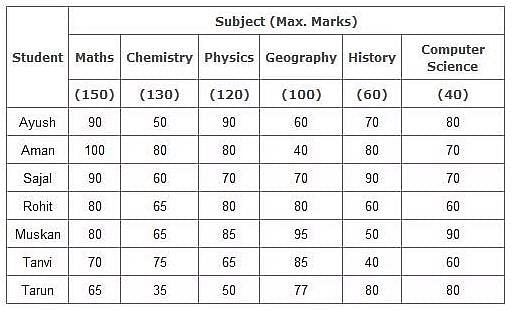
Q. What is the overall percentage of Tarun?
Directions: The following table gives the percentage of marks obtained by seven students in six different subjects in an examination.
The Numbers is the Brackets give the Maximum Marks in Each Subject.

Q. The number of students who obtained 60% and above marks in all subjects is?
Directions: The following table gives the percentage of marks obtained by seven students in six different subjects in an examination.
The Numbers is the Brackets give the Maximum Marks in Each Subject.

Q. In which subject is the overall percentage the best?
Directions: Study the following table and answer the questions based on it.

Q. For which state the average number of candidates selected over the years is the maximum?
Directions: Study the following table and answer the questions based on it.

Q. In the year 1997, which state had the lowest percentage of candidates selected over the candidates appeared?
Directions: Study the following table and answer the questions based on it.

Q. The percentage of candidates selected from U.P over those qualified from U.P is highest in the year?
Directions: Study the following table and answer the questions based on it.

Q. What is the approximate percentage of total number of candidates selected to the total number of candidates qualified for all five stages together during the year 1999?
Directions: Study the following table and answer the questions based on it.

Q. The percentage of candidates qualified from Punjab over those appeared from Punjab is highestin the year?



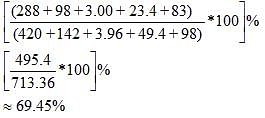
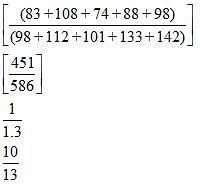
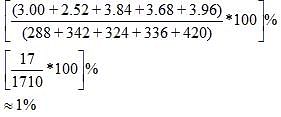


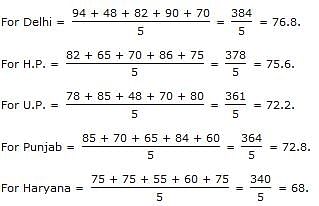

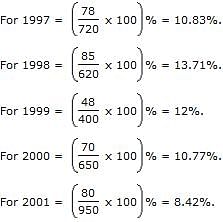
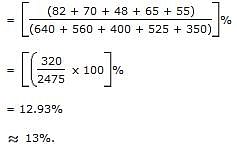
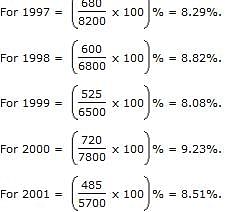 Clearly, this percentage is higher in the year 2000.
Clearly, this percentage is higher in the year 2000.














